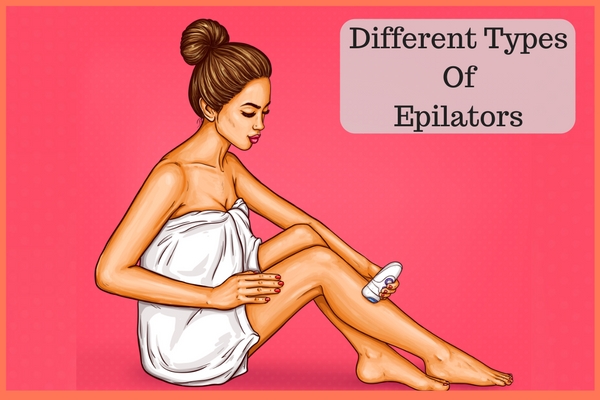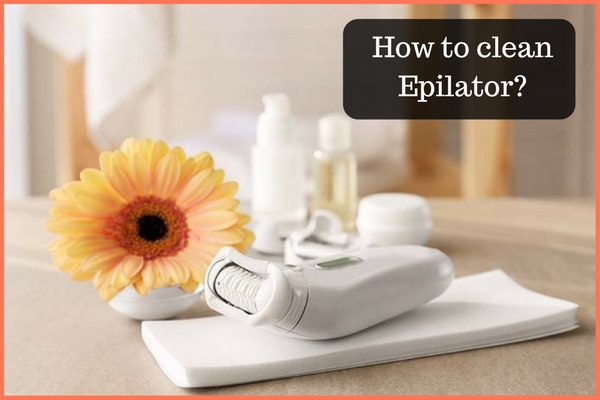What is an epilator And How does it work?
Epilators are electrical devices used to temporarily remove hair at the follicle level. They work the same way waxing or tweezing does, by plucking away hairs from the roots. As opposed to these methods, these devices use spinning discs or springs to capture hair on the skin level while the rotating motion of the moving parts pulls away from the hairs, leaving the skin smooth.
Epilators can provide people with a quick hair removal solution that lasts a long time. There are many efficient epilator devices constantly appearing on the market, and many of them are quite inexpensive. Some are cordless and use batteries; others are rechargeable, while some epilators are directly powered by a cord.
While these electrical provide a faster epilating action than other methods, they are generally more painful. However, their availability and ease of use make them among the preferred methods of removing unwanted bodily hairs.
Different Types Of Epilators:

Epilator devices have evolved from a battery charged spring-type ones to more modern cordless models. Here are the three main types according to their main parts and mechanism of action.
Spring type
The spring type epilators are the first devices to appear. They were developed in Israel released under the name Epilady. The design was quite simple involving a coil spring that was bowed into a curve. The spring was bowed in such a way that one part of the coil springs was squeezed close together while the others were apart.
The spring epilator also had a rotating mechanism which meant that the rotating spring would flex on one side and then on the other. Moving the epilator across the surface of the skin would have the coils grabbing hairs at the flexed side, and then the rotating motion of the skin would pull them out while the coils that were apart on the other side would squeeze tightly and grab and pluck other hairs. Because the springs would constantly coil and flex they were susceptible to failure and that is why springs were also sold separately as replacement parts.
Nowadays, spring type epilators are mostly used for removing facial hair, and they are usually referred to as face epilators. Some of them are manual, consisting of a spring and two handles that are turned to capture unwanted hairs and then pluck them out with a twist of the handles.
Rotating disc type
Rotating disc epilators use a similar action to spring-type ones but they use small rotating metal plates or discs instead of coiled springs. The first company to invent the rotating disc epilator was Remington, although there were some problems with the patent as the device had many similarities with the Epilady spring type. However, Remington won the patent litigation and this allowed them and other manufacturers to use this design that is based on rotating metal discs.
The rotating disc epilator has a few metal plates or discs mounted on the top of the epilator, protected by a plastic housing. This device works by rotating a series of small metal discs rapidly, with the moving tips causing an effect similar to tweezers. When disc tips are close together they grab multiple hairs while their rotating pluck out the hair away from the skin similar to waxing. The hair that has been pulled away is then discarded thanks to the centrifugal force caused by the rotating discs. Moving a rotating disc epilator across the skin will result in a continuous action of grabbing, pulling away, and discarding unwanted hair.
Tweezer type
The Tweezer type epilators have a somewhat similar design to rotating disc epilators, the notable difference being that the concept has been refined, with the discs no longer being complete, with the plates being discontinued in certain areas. This allows for a much more efficient pulling action.
All modern tweezer-type epilators have a head-on top which contains the tips of the moving plates. When the head rotates, these tips will come close to one another and then apart once per rotation. This causes the tip of the plates to first catch hairs between them in a tweezing action and then pull them out from the root, releasing them afterward.
As hairs have varying strengths and some may be more brittle than others, the tweezing action may sometimes cause the hairs to snap rather than to be pulled away. This can lead to stubble effect just as in the case of shaving. However, unlike shaving, tweezer epilators leave less stubble. Most modern epilators are of the tweezer type.
How do epilators work?

The fact that epilators are the preferred method of hair removal is proof of their efficiency in itself. Epilators can be used in a variety of situations and circumstances, and, since they are small, they can also be taken along when traveling. Epilators also provide a long-lasting effect being inexpensive whereas other methods may lead you to spend more money on creams, waxes, or razors. This makes epilators a real money saver in the long run.
Epilators cause no mess since you don’t need any creams or other substances for them to work with. Epilating devices work efficiently in removing every type of hair, from the dark and thick one to the light and thin one. Another benefit of using an epilator is to keep unwanted hair growth in check with minimum effort. Epilators can pick up hairs as small as 0.5mm, so give them some time to grow back a little and you’ll be ready for the next round in a couple of weeks.
What’s better, waxing or epilating?
Although waxing may have its benefits, epilating is generally considered more effective and convenient. Waxing takes a lot longer than epilating since in the latter technique you don’t have to apply warm wax, wait for it to cool and then pull. An epilator can also be used on the go in many areas, as you can simply put it in your purse and take it along with you.
Another benefit of epilating is that it will cost less, as you only have to spend money on an epilator once. With waxing, you will constantly have to buy wax, paper strips. Waxing may be less painful than epilating, but it can also remove less hair if not applied properly. Waxing will also imply a lot more mess since you may have residue wax, oils or you will have to treat your skin with creams afterward. So from the convenience and efficiency point of view, epilating is a better choice than waxing.
Additional Preparation Tips
Make sure your epilator is fully charged!
Epilators are power-hungry machines and only tend to last around 40 mins – 1 hour. There’s nothing worse than having your epilator die halfway through a session.
Wait until the evening.
Most people experience redness and small bumps for about 30 mins – 2 hours after epilation. This is nothing to worry about and is completely natural, but it’s not something you want to be sporting out of the house. I recommend epilating before bed so you can wake up to divine smoothness.
Be ready for a bit of pain.
If you’re a first-timer, you may have to wipe away a few tears. After a few times, it only gets better and is worth the pain!
How to clean Epilator?

You should clean the epilator after every use; it probably has a lot of bacteria build upon it.
Nobody wants nasty grease, sweat and bacteria, to make contact with their skin…
Though wet and dry, models are easier to clean, and epilator can be cleaned in a few steps:
Unplug the epilator, before cleaning it.
Step 1: Remove the Epilator top (head) from the main device
The head-on the most epilators can be released by pressing the two buttons on the side.
Step 2: Brush Cleaning
All epilators come with a cleaning brush to brush away loose hair. If you lost yours, you can use a toothbrush. First, remove any loose hair stuck inside. Then brush the epilator head. As you brush the head manually, turn the tweezer head, which causes the tweezer to open and close, making it easier to get out the hair.
Step 3: Use compressed hair to stubborn hair
You won’t be able to remove all hair with just included cleaning brush. One of the trickiest areas is removed hair is under the wheels. Take a can of compressed air to remove any hair wedged underneath the tweezer wheel. If you don’t have compressed air, you can try blowing on the epilator head using a hairdryer.
Step 4: Clean the head underwater
Some epilators feature heads that detectable, which can be cleaned under running water. Rinse the epilator head underwater and rotate the epilator head to make sure all the hair is removed.
Step 5: Sanitize the head with an alcohol-soaked cotton ball.
Rub the alcohol, on a cotton ball, and thoroughly wipe the tweezers to kill bacteria.
Step 6: Dry it
Thoroughly shake the cap and head so that the remaining water can drip out. It usually takes a day.
That’s how to clean your epilator. Your epilator is good as new.
The risks of not cleaning an epilator include the device malfunctioning and requiring a replacement head or other repairs, as well as risking an infection in the hair follicle due to using a dirty epilator. By keeping the epilator clean and hair-free after each use, and storing it with the protective cap on, these risks can be minimized.
The Aftermath
The first step after epilating is moisturization. Aloe Vera is a good option to soothe the skin.
Charge your epilator!
Users hate it when their epilator is not charged while they are ready to epilate. Some epilators take longer than others to get a full battery.
Clean up.
If you’re epilating dry, there may be some straggler hairs around that you’ll have to clean. Regardless of whether you’re epilating wet or dry, it’s always good to clean your device properly. This makes sure we reduce the risk of infection or skin irritation next time. Put your epilator in some cleaning alcohol and let it dry thoroughly.
Few Tips from my side
You won’t get great results with ‘slightly wet’ skin. Dry epilation is undeniably the most efficient method. I would recommend having a nice bath or a shower before epilating dry. Make sure not to use too hot water (it dries your skin out) and dry your skin thoroughly with a towel before using your epilator.
Start on a lower setting: Start on the lower setting, if you are the first Timer. This will make things a little slower, but you might appreciate the difference in pain while you get used to it. Testing the epilator on your hand first will let you get used to the sensation of epilation, before moving on to different body parts.
Keep your skin taut: epilating works best on flat surfaces, so it’s best to keep your skin as flat and tight as you can. This will help the hairs to stand up and be caught by the tweezers and will also make sure you don’t pinch your skin. Use your dominant hand to guide the device whereas others to pull your skin tight.
Keep the epilator at 90 degrees: In order to ensure the best effectiveness; try to keep your epilator 90 degrees to your skin (perpendicular). This makes it easier for the device to pluck your hair.
Slow and steady: Epilating is best done at a slow pace. If you move the epilator too quickly across the skin, it is more likely to miss hairs and you’ll just have to redo the area. If you go too quickly, the hair will get broken instead of being plucked from the root.
Against the grain: The most effective way to epilate is to run the epilator against the direction your hair is growing. Sometimes this can be difficult to see, and so moving the device in small circles allows you to pick up hair growing in different directions. Some epilators come with lights on them to illuminate the direction in which your hair is growing.
Be gentle: Don’t push down against the skin when epilating. You run the risk of pinching your skin with the epilator’s tweezers. Simply glide the head across your body and let it do what it was designed to do.
Epilation is an affordable and easy method of hair removal which is convenient to use at home. Cheaper than waxing, shaving, or electrolysis, it is possible to find epilators online at very reasonable prices. When you look at an epilator, choose the device that has the accessories that you need. The epilator is more or less the same, with the same tweezers and features. Only the accessories make the difference.
I hope my article has cleared all your doubts about maintaining an epilator. If you liked this post, then please do consider sharing it on social media platforms like Facebook, Google+, Linkedin, Twitter, Stumbleupon, Reddit, etc.
However, if you still have any query, then please feel free to let us know by dropping your doubt in the comment section below, I would be glad to help you out.

Best I have ever used is the Karmin